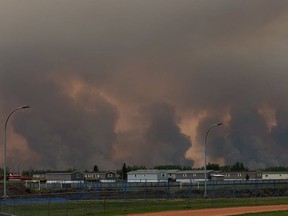
Article content
This month marks the three-year anniversary of the Chuckegg Creek wildfire, a devastating blaze that burned over 350,000 hectares in northern Alberta. What began as a small fire ignited by a lightning strike soon began to rage uncontrollably, fueled by high winds and dry conditions. Firefighters succeeded in protecting our homes and critical infrastructure, but not before the fire had destroyed 15 homes in the Paddle Prairie Métis settlement, just south of town. Mercifully, no one was killed.
advertisement 2
Article content
As the fire loomed over High Level in May 2019, and with the ghosts of the Slave Lake and Fort McMurrary fires in the minds of many, the decision was made to evacuate the town. Close to 4,000 people were evacuated from High Level, and about 10,000 people in the region due to Chuckegg. This operation was complicated by the fact the evacuation took place during the Victoria Day long weekend, when many residents were already out of town and unprepared for the full-scale evacuation that took place. Our residents were forced to disperse across the province, as far away as Edmonton and beyond.
To be separated so abruptly from family, friends, and community — to be severed from the place that gave them comfort, support, and belonging — was traumatizing for many, and it’s a trauma that endures to this day. I can still see it in people’s eyes and hear it in their voices when the subject of “next time” comes up. And let there be no doubt, there will be a future time.
advertisement 3
Article content
I want to thank Albertans for welcoming us when we had to leave, for the agencies, municipal employees and local citizens who made sure we had what we needed, and for the first responders who worked tirelessly to ensure most of us were able to return to our homes and belongings.
In the past 10 years, our region has experienced six of the hottest years on record, accompanied by unprecedented winds. The prevalence of extreme wildfire events is increasing across the globe, and Western Canada is no exception. This is a serious issue when your home is surrounded by boreal forest.
And then there’s floods, which are occurring more and more frequently. Just last week, our neighboring Dene Tha’ communities declared local emergencies and over 1,000 residents have been evacuated to High Level. We welcome them and will take good care of them because that is what northern neighbors do.
advertisement 4
Article content
Knowing what the future holds, the question, now, is how to be more prepared. In High Level, the answer is clear: we need to equip our community better to assist and house evacuations for what seems to have become annual events. To that end, High Level is planning a multi-purpose facility known as a “resilience hub.” As evidence from other jurisdictions in North America demonstrates, communities can be more resilient in responding to natural disasters if they put in place mechanisms to boost local capacity to recover, rebuild, and ultimately thrive.
During an emergency, the hub would serve as a center for response coordination and resource distribution. The facility would be able to accommodate 2,000 community members for the duration of a disaster. It will have the capability to provide services to people who have been displaced from their homes. When future disaster strikes, we want to be able to welcome people with open arms and provide comfort and support when it’s needed most.
advertisement 5
Article content
During good times, the resilience hub would serve as a community center, with a field house, an arena, and pool. Beyond that, it would provide flex space to accommodate our growing student body as well as be a community gathering place, with cultural design consideration for our Dene Tha’ partners, and other Indigenous neighbours.
With foresight and planning, we can mitigate the damage and trauma caused by natural disasters. Increasingly erratic and powerful wildfires and other climate events are unavoidable. Knowing that, the question is what we do? For High Level and Dene Tha’ First Nation, that means pursuing a common-sense solution — flexible infrastructure that can accommodate emergencies and improve lives in our northern community.
It is clear what needs to be done. Now, we just have to make it happen, working in the spirit of collaboration and determination.
Crystal McAteer is the oldest of the Town of High Level.